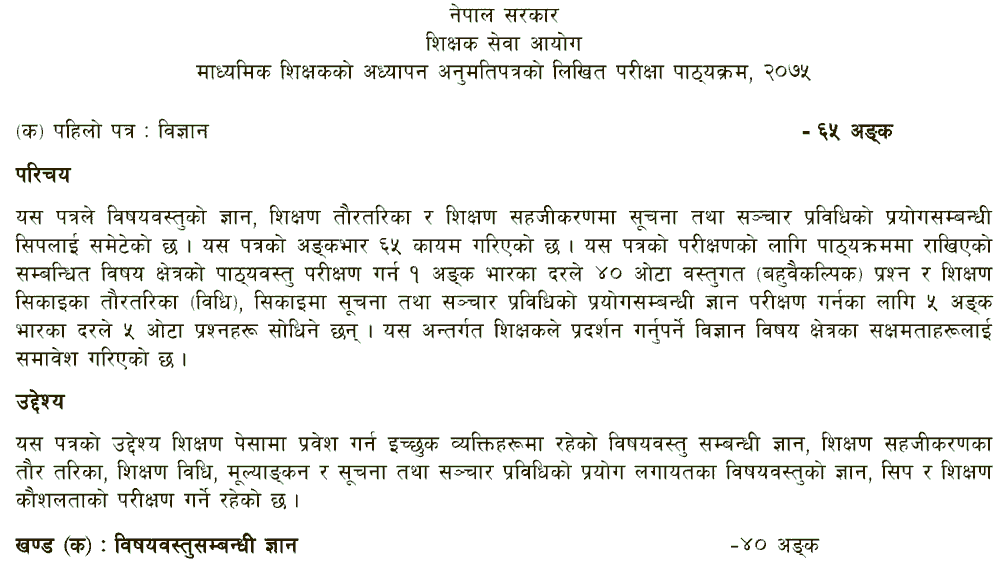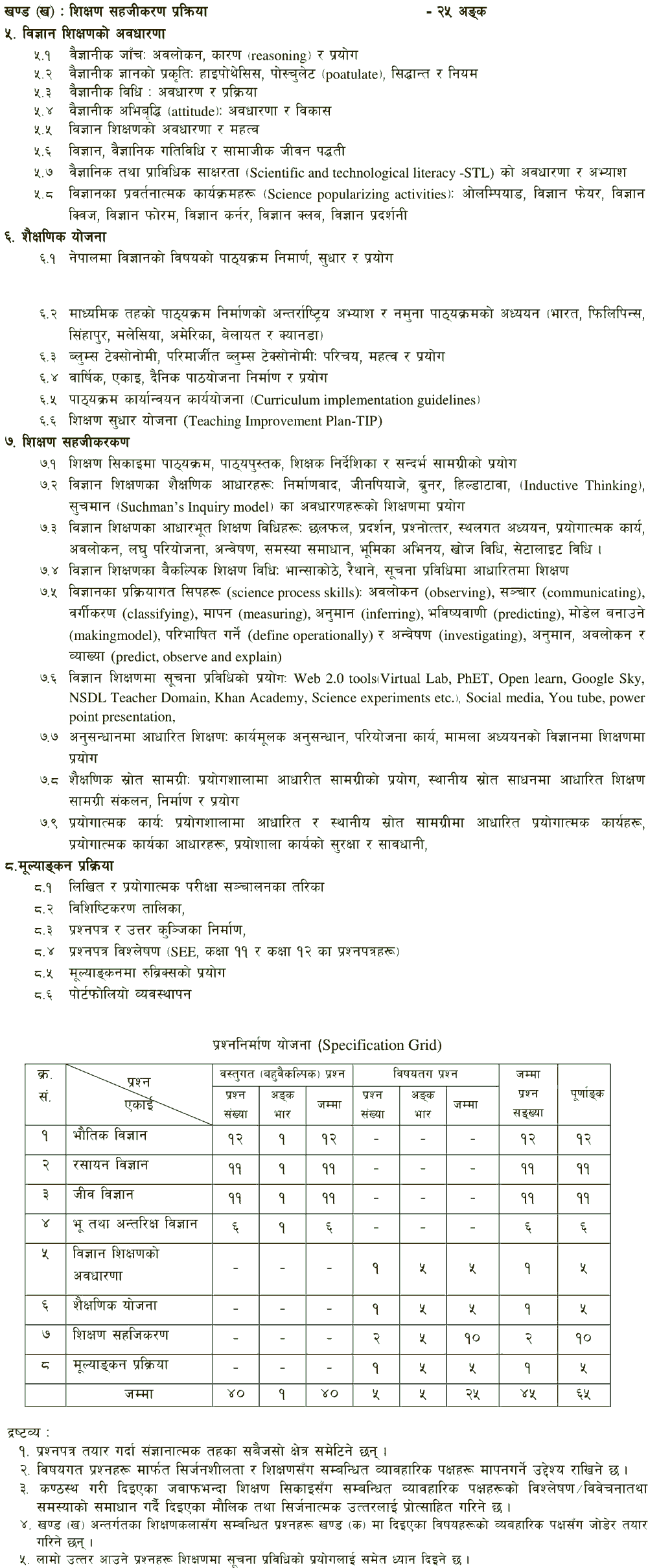
- Physics
1.1 Mechanics
1.1.1 Unit and measurement: Need for measurement, SI Units, Fundamental and derived units,
1.1.2 Scalar and vector quantities, parallelogram, addition, and the substation of vectors,
1.1.3 Simple machine: Introduction, Mechanical advantage, efficiency and velocity ratio, the law of moment, a moment of forces; torque
1.1.4 Force: Newton's law of motion, inertia, conservation of linear momentum, application of Newton's law of motion, Newton's law of gravitation, acceleration due to gravity, mass and weight, a variation of the value of "g", free fall and weightlessness, the motion of satellites, escape velocity
1.1.5 Work, energy and power: Work is done by a constant and variable force, kinetic energy, potential energy, work-energy theorem, conservation of energy, the relationship between work, energy, and power,
1.1.6 Fluid mechanics and dynamics: Pressure in a fluid, Law of flotation, Archimedes Principle, Application of atmospheric pressure, Surface tension, Newton's law of viscosity, Stokes law and its application, Bernoulli's equation and its application
1.1.7 Introduction of Rotational dynamics, Hook's law, and simple harmonic motion
1.2 Heat and Thermodynamics
1.2.1 Heat and temperature,
1.2.2 Measurement of temperature, thermometry,
1.2.3 Thermal expansion, liquid expansion
1.2.4 Heat capacity and Specific heat capacity, Newton's law of cooling, changes of phases, latent heat
1.2.5 Transfer of heat: conduction, convection, and radiation
1.2.6 Thermal properties of matter: Equation of state, ideal gas equation, molecular properties of matter, the kinetic energy of a gas molecule
1.2.7 Saturated and unsaturated vapor pressure, absolute humidity, relative humidity, and its determination
1.2.8 Introduction of first law and the second law of thermodynamics and its application
1.3 Optics
1.3.1 Reflection at curve mirror, concave and convex mirror, mirror formula, real and virtual images
1.3.2 Refraction through a prism: minimum deviation, the relationship between the angle of the prism, minimum deviation and refractive index
1.3.3 Introduction of lens, lens maker formula, power of a lens
1.3.4 Optical instruments: Human eye, defect of vision and its correction, camera, microscope, telescope and binocular
1.3.5 Nature and propagation of light, electromagnetic spectrum, Huygen's principle, the velocity of light,
1.3.6 Phenomena of interference, coherent sources, Newton's ring
1.3.7 Concept of diffraction and polarization of light
1.3.8 Defects of vision and their correction
1.3.9 Phenomenon diffraction and polarization of light
1 .3.10 Introduction of X rays and ultrasound and its application
1.4 Electrostatics
1.4.1 Electric charge, conductors and insulators, Coulomb's law,
1.4.2 Electric field, Gauss law, and its application, electric flux,
1.4.3 Potential and potential difference, Potential due to a point charge, potential energy, electron volt
1.4.4 Capacitance and capacitor, charging and discharging of the capacitor, a combination of capacitors, the effect of the dielectric, molecular theory of induced charges
1.4.5 Waves
1.4.6 Free, damped and forced oscillation,
1.4.7 Longitudinal and Transverse motion of waves, progressive and stationary waves
1.4.8 Reflection and refraction of sound waves
1.4.9 Velocity of sound in solid, liquid and gas, Effect of temperature, pressure, and humidity on the velocity of sound
1.4.10 Characteristics of sound: Intensity, loudness, pitch, quality, Doppler effect,
1.4.11 Concept of in wave and strings, the law of vibration of a fixed string
1.4.12 Principle of superposition; Resonance, Sonometer
1.4.13 Infrasonic and ultrasonic waves,
1.5 Current Electricity
1.5.1 Electric circuit
1.5.2 Ohm's law,
1.5.3 Electrical resistance, resistivity and conductivity,
1.5.4 Current-voltage relations,
1.5.5 Ohmic and in Ohmic resistance, Resistance in series and parallel
1.5.6 Consumption of electricity
1.5.7 Electromotive force and potential difference
1.5.8 Joule's law and its verification
1.5.9 Electrical circuits- Kirchhhoffs laws, Wheatstone bridge circuit
1.5.10 P.O. box, meter bridge, and potentiometer
1.5.11 Faraday's laws of electrolysis, verification of Faraday's law of electrolysis
1.6 Magnetic field of current
1.6.1 Molecular theory of magnetism
1.6.2 Methods of preparation of magnets
1.6.3 Magnetic field and magnetic lines of forces
1.6.4 Dip and dip circle
1.6.5 Relative permeability, susceptibility, hysteresis,
1.6.6 Dia-, Para- and Ferro-magnetic materials
1.6.7 Faraday's law of electromagnetic induction,
1.6.8 Lenz's law, eddy current
1.6.9 Generator, Dynamo and transformer
1.6.10 Introduction of alternative current, peak and RMS value of AC current and voltage
1.6.11 Solar battery, battery charger, invertors, adopter
1.7 Modern physics
1.7.1 Milikan's oil drop experiments. Cathode rays, the motion of an electron in an electric and magnetic field,
1.7.2 Quantum nature of radiation, Einstein photoelectric effect
1.7.3 Introduction of solids and semiconductor devices
1.7.4 Quantization of energy - Bohr's theory of hydrogen atom, the Uncertainty principle
1.7.5 Nature, production, properties and uses of laser,
1.7.6 Nature, production, and uses of X- rays, Bragg's law
1.7.7 Radioactivity: Alfa particles, Beta particles, Gama rays, law radioactive disintegration, half-life and decay constant,
1.7.8 Nuclear energy: Energy released from fission and fission, thermal and hydroelectric power, wind energy, Biofuels, solar energy
1.7.9 Particle physics and cosmology: Particle and antiparticles, Quarks, leptons, baryons, and mesons Chemistry
2.1 Atomic structure
2.1.1 Classification of elements: Mendeleev's periodic table, and the modern periodic table, division of elements into s,p,d and f blocks, electronic configuration, molecular formula,
2.1.2 Fundamental particles of atoms
2.1.3 Rutherford's and Bohr's model of an atom
2.1.4 Pauli's exclusion principle
2.1.5 Aufbau principle
2.1.6 Basic assumptions of electronic theory of valency
2.1.7 Octet rule
2.1.8 Chemical bonding: Covalent and coordinate covalent bonds
2.2 Chemical Reaction
2.2.1 Chemical equations and types,
2.2.2 Role of catalyst in a chemical reaction
2.2.3 Concept and electronic interpretation of oxidation and reduction
2.2.4 Difference between oxidation number and valency
2.2.5 Redox reaction
2.2.6 Concept and influencing factors of reaction rate
2.2.7 Rate law of equation
2.2.8 Half-life of a reaction
2.2.9 Concept of an activation energy
2.3 State of matter
2.3.1 Gas law: Boyle's law, Charle's law, Dalton's law
2.3.2 Kinetic model of gas, Ideal and real gas
2.3.3 Physical properties of liquid: Evaporation, condensation, vapor pressure
2.3.4 Solution and Solubility: Saturated, unsaturated and supersaturated solution, equilibrium in a saturated solution, solubility cure and its application
2.3.5 Crystalline and amorphous of solids, water crystallization, seven types of crystal system
2.4 Acid, base and salts
2.4.1 Properties and use of acid-base and salts
2.4.2 Ionization of weak electrolyte, degree of ionization,
2.4.3 Lewis concept of acids and base
2.4.4 Ionization of water, pH and pH scale
2.4.5 Hydrolysis of salts
2.4.6 Application of neutralization in daily life
2.5 Electrochemistry
2.5.1 Electrolysis, strong and weak electrolyte
2.5.2 Arrhenius theory of ionization,
2.5.3 Faraday's law of electrolysis
2.5.4 Electrolytic conduction
2.5.5 Variation of conductivity with concentration
2.6 Non-metals
2.6.1 Preparation, properties and uses of oxygen, hydrogen, nitrogen, ammonia and carbon diode
2.6.2 Water: structure, solvent properties of water, heavy water, use of water
2.6.3 Preparation, properties and uses of halogens (Chlorine, Bromine, and Iodine)
2.6.4 Preparation, properties use of carbon monoxide, phosphine, and sulfur dioxide
2.6.5 Position in periodic table and uses of Nobel gas
2.6.6 Environmental pollution: Air pollution, acid rain, water pollution, the greenhouse effect
2.7 Metals
2.7.1 General properties of matter, the difference between metal and non-metals,
2.7.2 Preparation, properties and uses of aluminum, silver copper, iron and gold
2.7.3 Preparation, properties and uses of quick lime, plaster of Paris, Bleaching powder and Epsom salt
2.7.4 Importance of mineral deposit in Nepal
2.8 Carbons and its compounds
2.8.1 Properties of carbon, organic and inorganic compounds,
2.8.2 Classification of organic compounds,
2.8.3 Functional group of homologues series
2.8.4 IUPAC rules of the naming of hydrocarbons
2.8.5 Preparation, properties and uses of alkanes, alkenes, and alkanes
2.8.6 Preparation, properties and uses of methane, benzene, alcohol, phenol, and ethers
2.9 Chemicals uses in daily life
2.9.1 Chemical fertilizers: Types and uses of nitrogenous, phosphate and potassic fertilizers
2.9.2 Preparation and uses of compost fertilizers
2.9.3 Some chemicals used in daily life: Cement, glass, fiber, ceramics, soap, detergents, pesticides (insecticides, herbicides, weedicides, and fungicides)
2.9.4 Polymer: natural and synthetic polymers, preparation of polymer, Polyvinyl Chloride (PVC),
Nylon — 66, use of Bakelite
Biology
3.1 Introduction to biology
3.1.1 Nature and scope of biology
3.1.2 Branches and of biology with other sciences
3.1.3 Importance of organic and inorganic molecules: carbohydrates, protein, lipid, nucleic, acid, minerals and water
3.2 Cell biology
3.2.1 Cell as a unit of life, structure, and function of cell organelles and inclusions
3.2.2 Mitosis and meiosis cell division
3.3 Biodiversity
3.3.1 Meaning and scope of biodiversity, flora and faunal diversity in Nepal
3.3.2 Characteristics and protozoa phylum, structure and reproduction of paramecium,
3.3.3 General characteristics and classification of Porifera, Coelenterata, Platyhelminthes, Aschelminthes, Annelida, Arthropoda, Mollusca, Echinodermata, and Chordata,
3.3.4 Earthworm: Habit and habitat, digestive and reproductive system, economic importance
3.3.5 Frog: Habit and habitat, digestive and reproductive system, economic importance
3.3.6 Life cycle of silkworm, honey bees, mosquitos
3.3.7 Structure and reproduction of Mucor, Yeast, Spirogyra
3.3.8 Life cycle of Marchantia, Funaria, and Dryopteris
3.3.9 Morphological structure of Cycas and Pinus
3.3.10 Angiosperm : Morphology, root, stem, flower, fruit, and seed
3.3.11 Structure and economic importance of bacteria, virus and fungi
3.4 Biota and their environment
3.4.1 Ecology: Introduction, abiotic and biotic factors and their interactions
3.4.2 Ecosystem : pond, grassland, mountain,
3.4.3 Food chain, ecological pyramid, productivity,
3.4.4 Adaptation : animal, amphibians, terrestrial
3.4.5 Biochemical cycle: carbon and nitrogen cycle
3.4.6 Wildlife conservation : meaning, importance, vulnerable and endangered species in Nepal, conservation practices( National parks, wild life reserve and hunting services)
3.4.7 Introduction of forest in Nepal, importance of a forestation and hazards of deforestation
3.5 Anatomy and physiology of organism
3.5.1 Plant anatomy : Types of tissues, meristematic and permanent tissue, internal structure of monocot and dicot root, system and leaf
3.5.2 Plant physiology : Water relation, photosynthesis, respiration, growth, plant movement
3.5.3 Animal tissues : Connective , muscular and nervous
3.6 Human biology
3.6.1 Nutrition: digestive organs and digestion of food
3.6.2 Respiratory organs and mechanism
3.6.3 Blood circulation : structure and function of blood, heart and its function, blood groups, blood sugar blood pressure , uric acid
3.6.4 Excretion : Excretory organs, mechanism of urine formation, temperature regulation, kidney and liver control system
3.6.5 Nerves system : types of nerves system, structure and function of brain, transmission of nerve impulse
3.6.6 Endocrinology: structure, function of pituitary, thyroid, pancreas,
3.6.7 Structure and function of eye and ear
3.6.8 Reproductive organs
3.6.9 Structure and function of skeleton system, classification of bones
3.7 Developmental biology
3.7.1 Reproduction and development of angiosperms : asexual reproduction, pollination, development of male and female gametophyte, fertilization and development of embryo in monocot and dicot
3.7.2 Sexual reproduction in animal : frog, fish, earthworm
3.7.3 Gametogeneisis in animals
3.7.4 Chromosomes and sex determination
3.8 Origin and Evolution of life
3.8.1 Origin of life
3.8.2 Theory of origin of life
3.8.3 Meaning of evolution, organic evolution
3.8.4 Evidences of evolutions
3.8.5 Lamarckism, Darwinism and Neo Darwinism
3.8.6 Human evolution
3.8.7 Structures of plant and animal cell
3.9 Genetics
3.9.1 Elements of heredity and variation, Genetic material (DNA and RNA),
3.9.2 Genetic code, Gene pool, Genetic expression and its regulation
3.9.3 Mendel's law of inheritance,
3.9.4 Concept of incomplete dominance and co-dominance,
3.9.5 Multiple gene, linkages, crossing over, Mutation,
3.10 Application of biology
3.10.1 Grafting. layering and tissue culture
3.10.2 Introduction to biotechnology, tissue culture, concept of breeding
3.10.3 Genetic engineering and its application
3.10.4 Application of fermentation technology
3.10.5 Antibiotics vaccines,
3.10.6 Tissue and organ transplantation,
3.10.7 Test tube baby
3.10.8 Poultry farming and fish farming
- Geology and Astronomy
4.1 Geology
4.1.1 History of the earth
4.1.2 Structure of the earth
4.1.3 Green House Effect,
4.1.4 Ozone layer and its importance, depletion of ozone layer
4.1.5 Climate change
4.1.6 Atmospheric layers
4.1.7 Natural disasters (Earthquake, lands slides, floods, snow fall, hurricane)
4.1.8 Environment pollution(acid rain, air, noise, water, soil, fuels deforestation)and management
4.2 Astronomy
4.2.1 Solar system
4.2.2 Galaxies
4.2.3 Rotation of the earth
4.2.4 Phases of moon
4.2.5 Lunar and solar eclipses
4.2.6 Comets, meteors and meteorites
4.2.7 Constellations
4.2.8 Zodiac Constellation
4.2.9 Identification of stars and constellations
4.2.10 Natural and artificial satellites'
4.2.11 Universe : Hubble law, Big Bang, Critical density, Dark matter
4.2.12 Black hole

Teachers Service Commission - TSC (Shikshak Sewa Aayog) has published Teachers license curriculum of Secondary Level (Class 9 -12), Science Subject.
Please Download Collegenp App from Playstore: Install Now for regular Update





